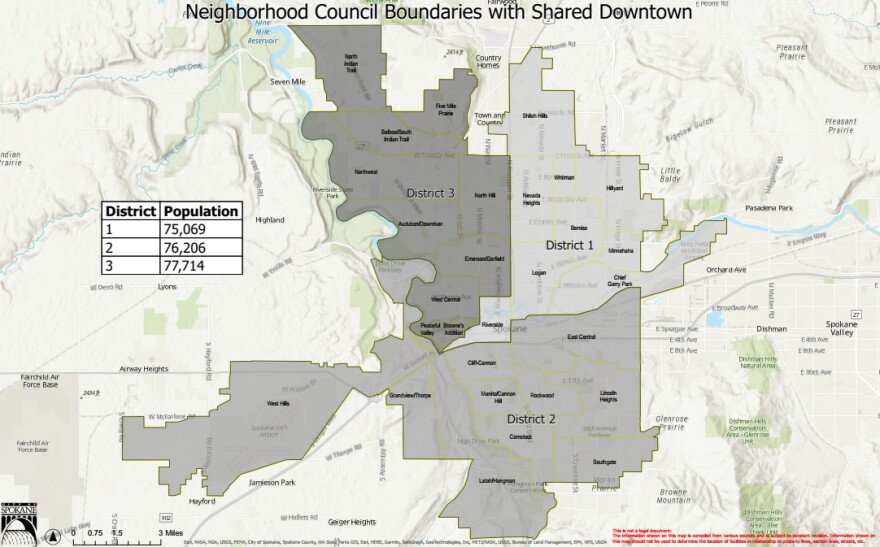The Spokane City Council decided this week to reject the recommendation of an appointed panel and adopt a council district map that some have complained favors a sitting council member.
The three-person redistricting committee was assigned to adjust boundaries to reflect population changes in the 2020 Census, while following rules built into city code. Those rules include making population as equal as possible among the districts, making them compact and geographically contiguous, giving no partisan or racial advantage, and preserving existing communities of related and mutual interest “to the extent possible.”
The committee’s own deliberations added another consideration: giving each of the three districts a “piece” of downtown Spokane.
In early October, the committee unanimously recommended a plan that included minimal changes to current district boundaries, and met the goal of a shared downtown. That version became known as “map 1.”
Three other potential maps emerged from the panel. One of them, called “map 2,” drew criticism because it moved Democratic-leaning Browne’s Addition to District 3. The move was thought to give an advantage to progressive candidates — specifically, sitting councilmember Zack Zappone.
While map 1 was the version to be considered at Monday night’s council meeting, a majority on the city council ultimately voted to go with map 2. District 3’s Karen Stratton asked if the council could take another week to consider the matter, but assistant city attorney Mike Piccolo told the council the clock had just about run out to approve a map before a November 15 deadline.
Though the council has to hold a second reading for the district plan November 7, the deadline for approving the new districts is so close that this week’s vote substantially locks in the council’s choice. Cutting the November deadline too closely, Piccolo said, might expose the council’s decision to legal challenges.
Divisions over the two maps were reflected in the public comment portion of the meeting. Thirty-six people testified.
Some, who spoke on behalf of neighborhood councils favored map 2, which they said would leave neighborhood groups intact and allow them to better coordinate on matters of their interest. Many of the residents who testified on their own behalf urged the council to adopt map 1. Several called any choice other than map 1 “gerrymandering,” as well as a deliberate rejection of public opinion and the redistricting panel’s recommendation. People speaking for local realtors and builders also favored map 1.
Councilwoman Betsy Wilkerson proposed map 2 as the official redistricting plan, saying its boundaries would put the East Central neighborhood into a single zone. Wilkerson represents District 2. East Central is a historically Black neighborhood that was divided when Interstate 90 was built. It's currently split by the freeway between districts 1 and 2.
“Contrary to what’s been said, I really am putting people over party,” Wilkerson. “Communities and neighborhoods are what’s important in District 2, and all these neighborhoods that would be split are in District 2.”
District 1 Councilman Jonathan Bingle said his interpretation of Washington state law supported adopting map 1. He also said Randy McGlenn II, chair of the East Central Neighborhood Council, said he appreciated the access to four city council members afforded him by the current split.
Bingle’s fellow District 1 representative, Michael Cathcart, proposed a compromise to adopt map 1, then adjust the boundaries again in five years, when the council could decide to make bigger changes. The proposal didn’t get any traction.
Wilkerson’s proposal to adopt map 2 was approved on a voice vote. Cathcart and Bingle voted “nay,” and District 3’s Zack Zappone abstained.
Karen Stratton, who serves with Zappone in District 3, said she sympathized with people who were disappointed by the outcome, but she said comments from her constituents favored map 2. Stratton also criticized the reproach that landed on Zappone after an Inlander report identified him as the creator of map 2.
“We’ve done nothing but badmouth him and blame him for this whole process,” Stratton said. “I’m disappointed in that.”
Rick Friedlander, chairman of the three-person redistricting committee, said in an interview that map 2’s boundaries carried no ulterior motive.
“Some nefarious ‘something’ was suggested, and I didn’t see that at all,” Friedlander said. “Nothing went out [of the committee] that wasn’t approved by the three of us.”
Council president Breean Beggs defended the decision to adopt map 2, saying, “In our process, under our ordinance, the commission makes some recommendations, and then council has to make the final decision. So for people to say, ‘You’re overruling the commission,’ no, the commission is advisory.”
Friedlander agreed.
“That really is their prerogative, so I have no argument about that,” Friedlander said. The committee’s work “came to end about 7:45 on Monday night. It’s not our decision to make. Ours was strictly a recommendation.”
Friedlander said he was surprised the council opted to go with a different map than the one the committee recommended, but said all four of the maps submitted by the panel met the legal criteria set out in city code.
The second reading and final vote on Spokane’s city council districts is slated for Monday night, November 7.
View map 1 and map 2 here:


